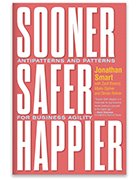How to measure the success of agile transformation
In his new book 'Sooner, Safer, Happier,' Jonathan Smart dives into the ways in which organizations can achieve better outcomes through business agility.
Business leaders across industries today are looking to adopt agile principles within their organizations to spur innovation, empower teams across departments and further drive business outcomes. But how exactly do they approach what you would call an agile business transformation?
In his new book, thought leader, coach and business agility expert Jonathan Smart identified the antipatterns and patterns that show the different ways to build and sustain an agile mindset in any industry, not just IT or software development, and discusses how to measure the success of agile transformation.
"To succeed, organizations are recognizing the importance of being proficient in ways of working suited to and leveraging the increasingly emergent nature of work and the continuous pace of change," Smart wrote in his book Sooner, Safer, Happier: Antipatterns and Patterns for Business Agility. "Organizations are recognizing a need to exhibit business agility. These ways of working are not specific to IT, nor to any sector. They are essential to survive and thrive in the Age of Digital."
Throughout the book, Smart focused on the outcomes businesses leaders should aim for to improve ways of working as they apply agile practices within their organizations. He defined them as Better Value Sooner Safer Happier (BVSSH).
Better refers to quality; Value can vary and is why someone is doing what they're doing; Sooner is having time to market, learn, pivot and see progress as early on as possible; Safer is ensuring continuous regulatory compliance and resilience during a major disruption; and Happier is achieving customer advocacy and employee engagement while factoring the impact to society and the climate as a whole.
"Each of these elements balances the other. You can't force Sooner, as there will be a downward trend in Better and Happier," Smart wrote. "Improving on BVSSH is not prescriptive. Measures are vector metrics (trends) rather than absolutes so that improvement over time can be compared. No one is exempt from improving."
Take a look at an excerpt from Chapter 1, "Focus on Outcomes: Better Value Sooner Safer Happier," to learn more about BVSHH and how you can apply business agility in your organization today to drive better outcomes.
 Click here to purchase
Click here to purchase





